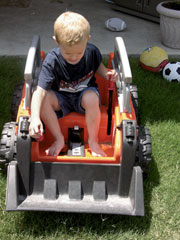 |
 |
 |
|
AAIS Perspective Miniature vehicles Agents and insureds need to know when coverage is or is not in place By Joseph S. Harrington, CPCU There are hundreds of thousands of miniature motorized vehicles in the United States today, including motorized skateboards, scooters, motorcycles, “go-karts,” and others. Such vehicles have become so common that municipalities have enacted ordinances regulating and restricting their use on public roads and sidewalks. Despite those laws, most parents are probably not aware that they may not be insured for their children’s use of miniature vehicles, unless parents have acquired specific insurance for them. There are two circumstances in which standard homeowners policies provide liability coverage for bodily injury and property damage (BI/PD) arising from recreational vehicles designed for use off public roads: • Cases where the vehicle that caused the damage or injury is not owned by the insured So, if a child injures a pedestrian while using his or her own motorized vehicle in a public place, there is typically no coverage under a standard, unendorsed homeowners form. 15 mph To have coverage, the parent in such a situation would have to know beforehand to purchase a standard motorized vehicle liability endorsement. Even that might not guarantee that coverage is in place. In their standard form, such endorsements typically add liability coverage for recreational vehicles owned by the insured, and for occurrences away from insured premises—but only for vehicles that travel no faster than 15 miles per hour on level ground. Judging from advertisements, there is no little or no general awareness of the 15 mph standard among manufacturers and distributors of miniature vehicles intended for use by children. Most parents would probably be surprised to learn that an electric scooter that looks like a toy would not qualify for coverage under standard motorized vehicle liability endorsements, because its manufacturer advertises a top speed of 17 mph. Yet a miniature electric motocross motorcycle that is bigger and resembles a vehicle used by adults could qualify for coverage under such an endorsement because its advertised top speed is only 15 mph. (To remain qualified for coverage under the endorsement, the vehicle could not have been modified to exceed 15 mph.) This indicates that parents and agents cannot rely on their own subjective assessment of whether use of a particular vehicle is covered under motorized vehicle liability endorsements. They must consult the product specifications. Kiddie cars Motorized vehicle liability endorsements would certainly cover damage or injury arising from small ride-on vehicles used by young children, sometimes referred to as “kiddie cars.” These types of vehicles generally go 3-5 mph, well below the 15 mph threshold. Such vehicles are clearly designed to be toys, and a parent might assume that use of them by children would already be covered without restriction under a standard homeowners or personal liability policy. Under a strict reading of such policies, however, there is no liability coverage for off-premises use of any type of owned self-propelled vehicle without a motorized vehicle liability endorsement. Some carriers have told AAIS they could accept a broadening of homeowners liability coverage to provide coverage for slow-moving toy vehicles without requiring an endorsement. In response, AAIS has added a new provision to its revised homeowners base forms now being filed countrywide and due to take effect in 2007. Under the provision, liability coverage is extended to BI/PD arising from self-propelled vehicles owned by the insured and used away from the insured premises, provided the vehicles are battery-powered and do not exceed 15 mph. Care required Vehicles powered by gasoline or other fuel are not covered under the new AAIS provision; nor are vehicles designed or modified to exceed 15 mph on level ground. If an insured wants off-premises liability coverage for a gas-powered vehicle he owns that travels 15 mph or less, he will still need to purchase a motorized vehicle liability endorsement. If an insured wants liability coverage for any type of self-propelled vehicle that exceeds 15 mph, he typically will need to find other insurance for it. Consumers may think insurers are splitting hairs by making distinctions among vehicles, but insurers are trying to maintain a clear line between vehicle liability coverage and personal liability coverage. Agents can help by counseling their clients to be mindful of the safety issues and insurance implications that arise when they purchase self-propelled vehicles, including “miniature” ones. * This article is general in nature and is not intended to provide definitive information regarding use of AAIS products and services, which is restricted by copyright and license agreements. This article in no way alters, supplants, or supersedes what is written in AAIS policy forms, manuals, bulletins, or other communications, and it does not indicate any official AAIS position on the matters discussed in the article. The author |
|
|||||||||||||
| ||||||||||||||
